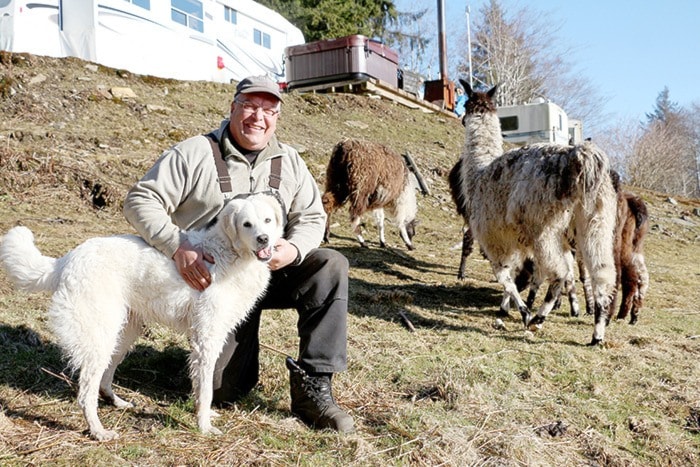On the drive out to the North Pacific Cannery, on occasion, one can spot a pair of bulbous eyes atop the long wooly neck of a llama, as it takes a break grazing the field to stare back.
Edward (Ed) Day — the llama keeper — lives on a cleared piece of land that dips into the ocean at the mouth of the Skeena River, where the Inverness Cannery once stood, and where he keeps an incongruous herd of seven llamas.
“The dark brown one, the larger one, she’s the first we bred on our farm,” Day said pointing out the llama he calls wi jah ha, Gitxsan for “big eyes.”
The restoration crew supervisor for the North Pacific Cannery, used to live in the Hazeltons on Gitxsan territory, where his wife’s family is from. Alice Kruta and Day had a farm with property at the base of a trail. With such a beautiful plot of land, they decided to delve into eco-tourism and offer trekking with llamas.
The llamas, which pack one-third of their body weight, helped him carrying materials to build cabins along grizzly bear trails by the Babine River. At the time, he had at least 22 llamas. Their scent acted as a guard against the bears, Day said.
“The smell, which we don’t notice, is quite unrecognizable. It’s like aliens have landed and they’re walking around with a man, it can’t be a good thing,” he said with a chuckle.
Even now, on the outskirts of Port Edward, Day said his llamas keep the wolves and bears away from his property. They also keep the grass and weeds trimmed.
In 2008, they sold the farm and returned to the North Coast. The couple had moved to Prince Rupert in 1981 after meeting in Dawson Creek. To escape the harsh winter, they sold everything they had. On a budget, they bought a pick-up truck and a camper they called The Hobbit and traveled as far west as they could.
“The guy who built it must have been five-feet-tall because I could never stand up in it straight,” Day said, who is six-foot-one.
When they arrived in Prince Rupert the city was booming. Day worked on building new homes in the developing city. But finding a place to rent was tough, especially since they had a large dog. For a year, The Hobbit became their home.
Without the convenience of cell phones, Day would drive their camper out to his worksite. After Kruta finished her day at work, she would have to walk in the rain to find where he parked their home.
Living like nomads was all part of the adventure. On weekends, they would drive into the wilderness to soak in the mountains and the lakes to reboot before another week of work.
“Construction has been my career my whole life,” Day said. For more than 30 years he had his own company, Day-Light Construction.
He is trained as a carpenter, bridgeworker and piledriver. He was a heavy equipment operator, and when he wanted to explore Canada, he acquired his Class 1 drivers licence, bought a truck and drove across the country.
“You’ve got a bucket list of all these toys you want to play with, that’s sort of what it is,” Day said.
Construction is his passion, yet he’s a whiz on all subjects. Day could easily be a contender on Jeopardy — his mind is a hive of information from carpentry to cannery history to llamas.

The old Inverness Cannery grounds, where he now lives, has become a sanctuary for him and his wife. The couple bought the land after their daughter, April, had purchased her first home in Queen Charlotte Village.
He couldn’t believe that her first home was basically his dream home. “I said to Alice, ‘That’s it, we’re getting waterfront property.’ I started searching and that’s when I found this.”
Coincidentally, Day said he was born on Inverness Street in Vancouver.
The couple didn’t move onto the property right away. They lived in town and visited the land on weekends, clearing trees and wandering the beach looking for smooth pieces of green or blue glass — relics of people who had lived at the old cannery.
Since moving to Port Edward, he has also been a part of the restoration of the North Pacific Cannery. As the crew supervisor, he mentors workers through an employment-retraining program.
The work on his future dream home was put on hold recently, when Day faced some of his toughest years. At the end of 2014, a fire consumed their home in Port Edward. Then, while they were dealing with the insurance they found out their daughter had terminal cancer. It wasn’t until 2016 when they moved onto the Inverness property indefinitely.
Beyond the gated entrance, Day has a network of fifth wheelers and campers, with an outdoor wood stove and a hot tub on the deck.
“The camper is sort of my office, the office I never go to because the weather is too nice,” he said, smiling under the sun.
Eventually, he has plans to build an energy efficient home, and possibly even a healing centre.
“Friends of ours come down here because they feel the energy is here. It’s such a beautiful spot and it revives you,” Day said. This winter, at least four-dozen harbour porpoises have been frolicking in the area — visible from his outdoor patio.
